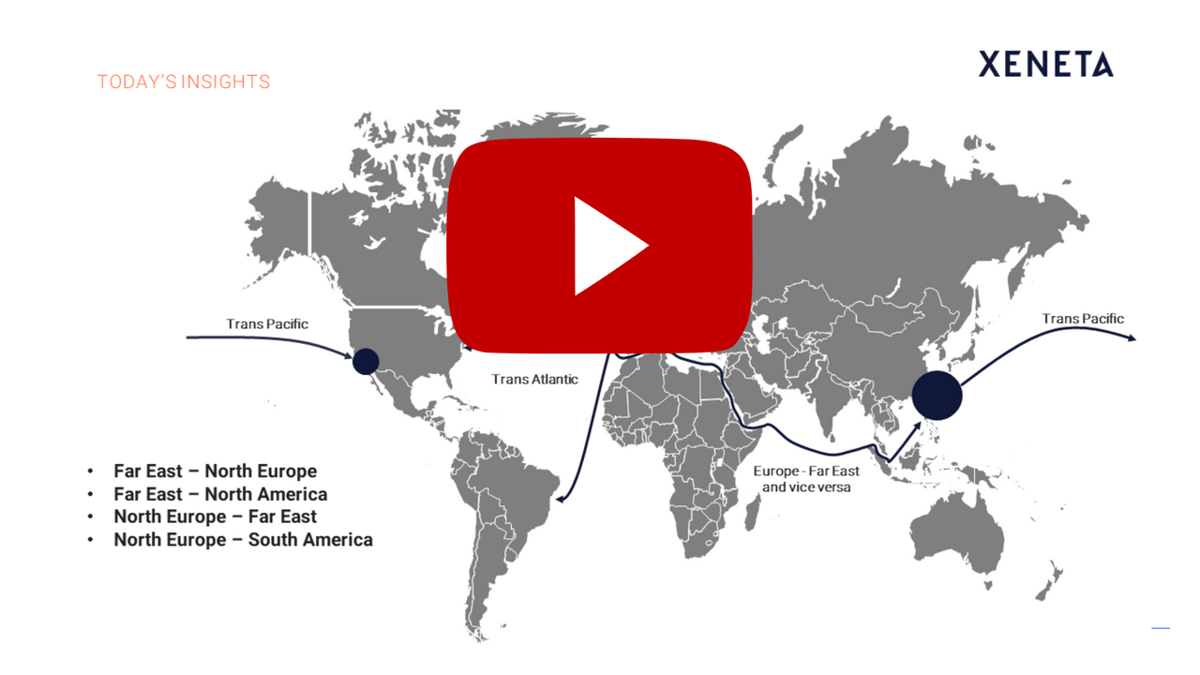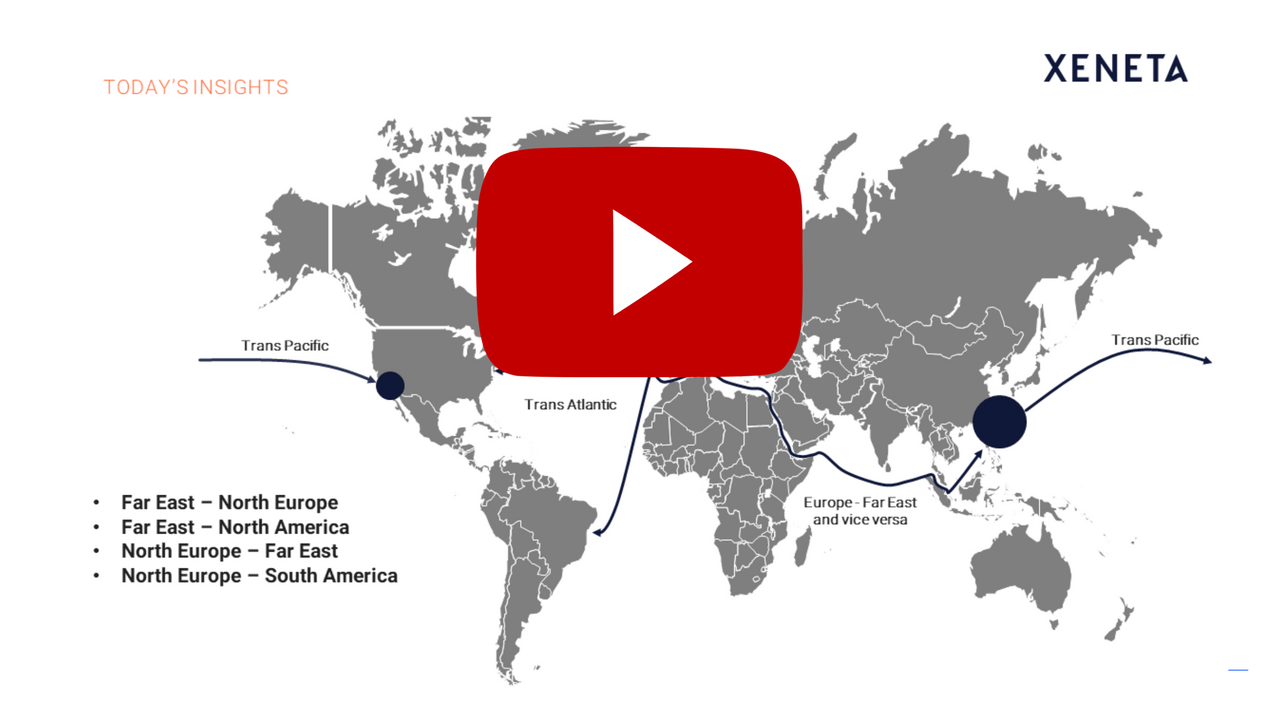In our latest quarterly webinar, we've reviewed the ocean freight rates for the past quarter. We analyzed the main trade lanes:Asia-Europe (import and export), Trans-Atlantic, Trans-Pacific. Due to the latest market developments, we've also reviewed the trade lane Europe to S.America West Coast.
Get useful tips from Xeneta expert, Michael Braun on how you can instantly monitor the market, use this market intelligence data with in your procurement teams, and how you can report. By watching this webinar, learn how to make your sourcing teams more efficient during the RFQs and tendering periods and get access to all the intelligence to keep up with the market.
Click Here to access the recording.
Get the webinar
- Presentation transcript: Read below (or download full transcript in PDF format)
- Live Q&A session: Read answers to common questions from the webinar
Presentation Transcript:
Katherine Barrios: [00:02] Welcome to the "April 2018 Ocean Freight Rates at a Glance" webinar. My name is Katherine Barrios. I am the Chief Marketing Officer at Xenata, and I am joined today by colleague, Michael Braun, who's the Director of Value Engineering. He will be the presenter today.
[00:28] The webinar's scheduled for 30 minutes. We'll do a Q&A of five minutes at the end.
[01:13] We're going to talk a little bit about today's agenda. There's a lot going on. We're going to cover first what's been happening in the past quarter for these main trade routes and especially what's happening in South America given the latest market developments.
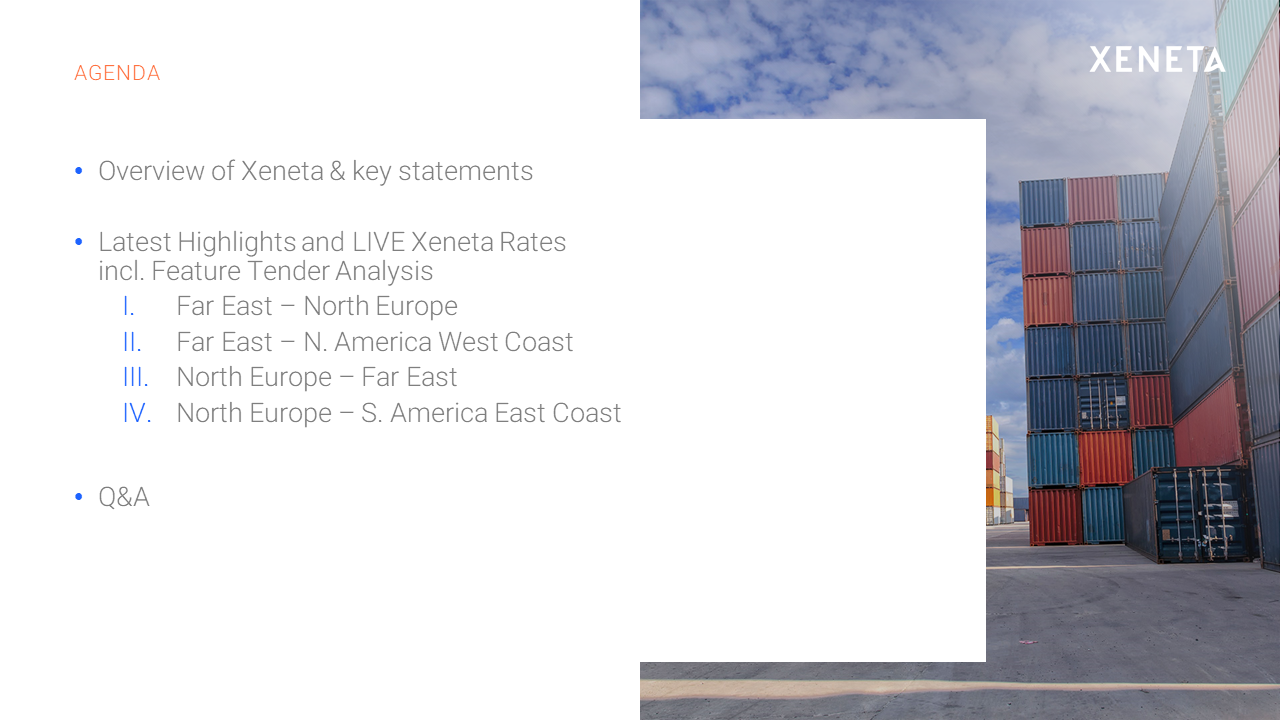
[01:34] As many of you know, the market has been rather volatile. There's been a big decrease in some rates and stabilization and up and down. Volatility is definitely there. This is definitely the time to make sure that we have all the intelligence that we need to keep up with the market.
[01:53] We'll go through Far East‑North Europe, Far East‑North America West Coast, the Trans‑Pacific, then North Europe and Far East. As I mentioned, we'll also do North Europe to South America East Coast, given what's happening lately.
[02:07] In addition, we're going to first also give you some background on how you can use the Xeneta data in your everyday procurement teams, how you can instantly monitor the market, how you can report, how you can make your sourcing teams more efficient during RFQ and tendering periods.
[02:25] Also, especially to stay abreast of what's happening now and given that peak season is coming and also some GRIs that are anticipated already next week, I believe, and the weeks after as we move into the summer.
[02:37] That is about it for my introduction. I'm going to hand it over to Michael. We'll get started. Michael?
Michael Braun: [02:43] Thank you very much, Katherine. Welcome everybody from my side. As already mentioned in the agenda, we are going to start with a quick overview of Xeneta.
[03:12] For today, we will then focus on the most important rates, what we see at least in our customer base, where we have the most overlap of it. To give you a quick overview on how we are usually addressing these markets, what kind of value our customers can get out of it.
[03:37] Quickly, firstly, for the ones never having heard of us. What is Xeneta doing? We are a company which thinks that especially in the ocean freight sector the missing transparency about market movements and the price levels is one of the key obstacles.
[03:52] Our goal is that we want to provide all market members and all of our customers with accurate market information, market indices so that they are able to benchmark their own ocean freight performance.

[04:08] That they can receive market intelligence about the ocean freight market so they can do an optimized procurement approach. We think that if you can't measure anything, you can't really manage it.
[04:20] That's our pure conviction, that we want to put more lights into this kind of industry so that all participants can profit from this higher transparency level.
[04:31] We've been founded in 2012. We are now a group of over 60 employees. Our headquarter is in Oslo, Norway and sales offices for our customers in Hamburg, Germany, and Manhattan, New York for the US market.
[04:52] Overall to give you a little bit of a key data about Xeneta, we now have 45 million contracted rates in our database. One important thing to know is we only display market information about contracted rates.
[05:08] You can be sure all of these rates have been contracted between the carrier base on the one side and the freight forwarders or the shippers/BCOs base on the other side. We are not talking about offers. We are not talking about any kind of price levels, standing in any kind of official documents, but only offered rate levels where contracts have been made short‑term and long‑term.
[05:35] Overall, with that information, we can today cover 160,000 port pairs. An overview and not only in the major ports and trade lanes what we cover today, but really going in the oddest odd ports somewhere in Asia, in South America, and so on.

[05:54] What is also important to know is that all of this information is updated daily and in real‑time. It's not like this that we only collect data, I don't know, once a quarter or once a year but that we constantly collect our data and that it's been then also updated daily.
[06:10] So that when we are now looking today into our platform, you will see results of mid‑April, of just literally today. In that context, it's also important we are completely transparent with what we are going to share with our customers. That also means that we are completely independent to any market members.
[06:29] We don't belong to the carrier base. We are not paid by freight forwarders or the customers or that they have any share. We are a completely independent and neutral data source. We also supply our services to all partners in the market if they become a customer.
[06:44] Over the last five years with this kind of a success, we also became a quite valuable partner when it comes to overall transparency in the market and to the general financial press.
[06:59] In that way, we are happy to say that our index is not only used by numerous freight forwarders, shippers and carriers, but also by the global trade press or the global financial press.
[07:14] Now coming into specifically, apart from the press, who is using our tool, our market data. There are two large groups to be identified. On the one hand, we do have the shippers.
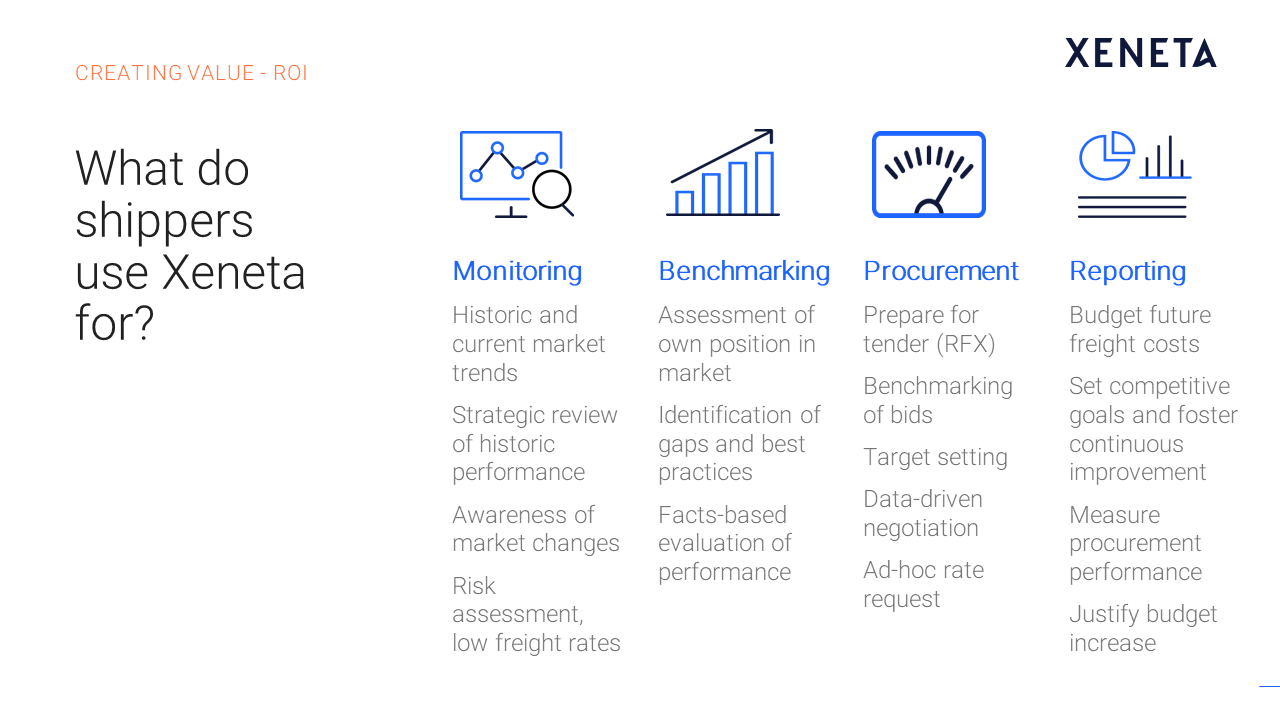
[07:28] The shippers, they use it for four main different aspects. The one, that's pretty much the one where we are looking at today, it's monitoring the markets.
[07:38] Following up on the latest rate developments, seeing if there have been any general rate increases, and getting a picture how the market has been acting and moving throughout the last couple of years. We are now able to look back at least three to four years on most markets.
[07:56] The next thing, of course, is if you have a transparent market reference, you can benchmark yourself against it. So that you can identify gaps and best practices of other shippers, of other freight forwarders to really identify your own position in the market. If you are towards the market low or if you more belong towards the average.
[08:15] This is, of course, then also a very valuable support towards the further procurement of your rate levels. Going into the next tender, even benchmarking your bids, setting your targets. That's exactly the next step what our customers are using our platform for.
[08:31] Then in the end, just get to an overall common reporting. Looking backwards, benchmarking, looking at the current tender, procurement, looking forward or at the current market development on the monitoring.
[08:44] Then using all these kind of KPIs to generate reporting which they either use internally or even towards the carriers or towards other services to get good management reports.
[08:57] Pretty much the same applies to freight forwarders, but for them there are even more use cases on top. The first thing is the kind of daily procurement approach.
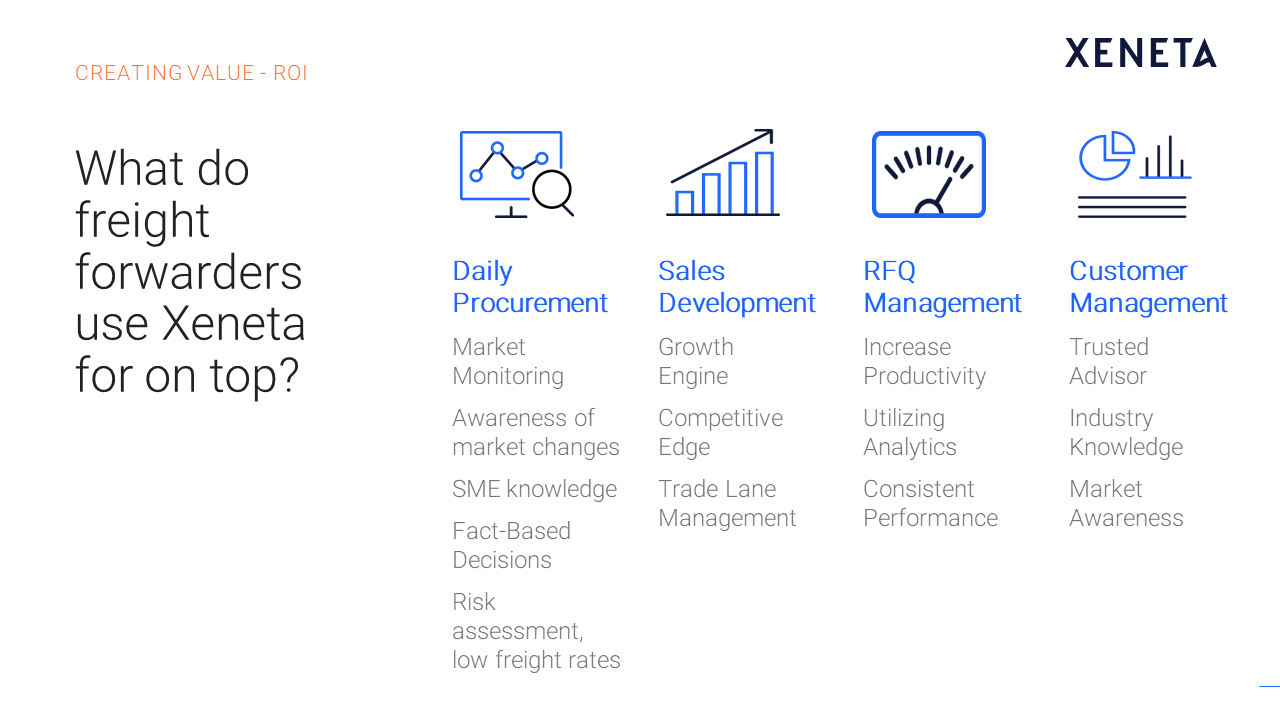
[09:09] As we are supplying daily data and as they are actively acting on the market on a daily base, here it's important to not only have general trend information on a monthly or quarterly level but going down to the days.
[09:24] Then on top, freight forwarders are not only procuring ocean freight themselves, for which they can use the same levels than all other shippers because literally speaking they are nothing else but large shippers in that way.
[09:36] They can also use it on top towards their own customer base, either by using it for developing further sales, meaning identifying gaps in areas where they are not yet that much successful and just analyzing the overall market level there to see if their own pricing had been competitive.
[09:55] Or, for example, for RFQ management. In answering tenders of their own customers where they ask for numerous and thousands of initial bids, sometimes on market levels where they are not active and where they don’t yet have the contracted rate levels.
[10:10] Of course, they need to have some kind of a ballpark figure to go in with the first strong bid, before they then resource the volumes again with their carrier rates, as well. In that way, the information what we can provide with our database is, of course, also very valuable for them to answer their tenders, as well.
[10:30] Last but not the least, like the internal reporting of the shippers, they can even use the same reports for their own customer management. For the accounts they are serving, acting as a trusted advisor and just showing them the transparency and how good was their own procurement performance.
[10:47] Most of the accounts which work at freight forwarders request this information nowadays, as well. With that one, they get this kind of outside relevant trusted source to just get a measurement from a third party which is independent.
[11:02] These are pretty much the use cases what we see with our customers. As you can see, there are numerous levels. Of course, not everybody is using all the different levers.
[11:13] Same applies to our product. We have different levels of support.
[11:25] We are happy to provide you with the detailed information you need, and generate a specific proposal addressing your direct needs in that one, so that the value you are looking for, you can directly gain from it.
[11:39] For the remainder of today, I don't want to spend more time on the kind of values we would like to give you on a high level but go into the specific overview of a couple of markets, just that you get a little bit of an idea how the market is working.
[11:54] As Katherine has already mentioned, we are starting with the Far East to North Europe trade, as it's still the largest one, then moving over to the Trans‑Pacific, having a look at North Europe to Far East.
[12:05] Also, today, a quick view into the South American market since there has been a couple of recent changes in that market you are probably aware of. I'll now switch over directly into our tool.
Michael: What you are seeing here now is one of our screens what we are supplying on our platform. As you can see over here, there are different levels and levers of information what we can provide, also spend overviews, budget overviews, benchmark reports.
[12:45] As we are concentrating today on the recent market development, these are the corresponding screens to follow up there. We are on the level of Far East Main, so all the main ports within the Far East towards Northern Europe, to just give you a high‑level overview.
[13:01] We also look at the development over the last two years. We compare the market development on the one side, the short‑term market, and the other side, the long‑term market, which has been tendered with three‑months and one‑year contracts throughout the last two years, so that you really can compare these two different markets.
[13:21] The upper one is the typical spot market, short‑term rate levels up to a month, mostly two weeks, mostly provided by the freight forwarder base, where you can see that the earlier years have been driven by a quite upward direction with a lot of successful general rate increases.
[13:36] The recent market development has gone downwards, so that we are now again back on the level which is pretty much on 2016 level again. It will be very interesting to see if this trend is now pursuing, or if we do see changes again with any successful general rate increases coming into place.
[13:57] At the moment, this market is hot. A lot of things are happening. The downward trend is there, but the question, of course, is how long this will hold on.
[14:06] Everybody going out with a tender in due course or in middle of the negotiation, is deeply recommended to follow that kind of a market development closely.
[14:17] At the moment, the trend is like this, that the carriers are more looking into market shares, beating down the prices, competing with each other, contracting on a lower level week by week.
[14:29] Not trying to get a kind of a consolidation and a constant level, what we had the years before, where you can also see that the rate level always had been on an upward trend, or at least throughout the last year had been on a constant level, in our case now for a cadence wire rate for a 40‑foot container of an average of 1,450, 1,490, 1,500 all over.
[14:49] As you can see now recently, that one has dropped. That's why it's important to follow up that one closely, and to see if it goes on like this.
[15:06] In addition to that, just to show you that's the kind of high level trend information what we can provide, but as we already said, we can even display the full market picture. Not only the highs, but also the market lows, which are, of course, very interesting and relevant for the people which are on the lower level.
[15:23] Same applies to others which have probably higher evaluations or are looking for more service‑oriented procurement. We can display the full market picture, and that on a daily base, and from the past on, so that you can follow up on the recent market development and identify the kind of trades what I have just shown within that picture.
[15:48] You also have the possibility to just nail down specific views to certain corridors, such as looking at the recent rate development or whatever. There are multiple possibilities you can do, also do calculations and so on.
[16:01] In that way, please feel free to contact our sales team. They are happy to provide you with an individual demonstration, also going in different markets, and just giving you then the best overview possible.
[16:16] Going on from the Far East to North Europe main market, I'll switch now over to the Trans‑Pacific. That one had in the recent time followed a little bit similar development. There has always been a downward trend.
[16:31] We had been in the peak season beginning of last year, just around the TPM. We had been up on a high of around $2,000 for the short‑term market. This has now continuously dropped.
[16:42] There had been some general rate increases, but they were always not that successful. At least not in the long run, which led to the fact that the rate level overall and the market stayed in a certain corridor. That one has then also diminished towards this year.
[16:56] Up until the TPM, or just before the TPM, there was still a downward trend. That downward trend has now recently been stopped a little bit. It looks like that we are not really going significantly down, as we did on the Far East to Europe trade.
[17:15] It looks like that the carriers were able to stabilize a little bit the market development. You can also see that the long‑term rate levels have not really changed that much. Throughout the last 15 months, it has more or less been stayed on the same level.
[17:32] It looks like that at least the recent short‑term general rate increases, what the carrier base has created, has been successful in a way to at least stop the downward trend. It looks like, at least in my opinion, as the TPM has now been over, and as there has not been any significant changes there, it has been quite a calm one.
[17:52] People were discussing about different topics ‑‑ supply chain, efficiencies, cybersecurity ‑‑ but not about recent market development in a significant way that we have major changes there. More towards when it comes to availability on the truck market, but not on the ocean freight.
[18:08] It looks like that this market is going to stay calm throughout the next period. I don't expect extreme market developments but, of course, we never know. We can only look as far as the market is playing at the moment. It must be closely followed. It looks like that it's more equalized then, especially the Far East to Europe market in that way.
[18:30] Next market, what we're looking at, North Europe to Far East Main, a very interesting market last year. As you can see over here, what kind of extreme increase we have seen throughout the last year. Pulling up the short‑term market extremely, having a lot of capacity shortages and so on.
[18:51] Also, then, on the long run, pulling up the long‑term market by even a 100 percent. Here, we can't really see that this kind of trend has come to an end and has reverted back to calm levels again. Now, the market situation is really calm.
[19:06] We are even back to the same rate level that we have seen in winter last year before the whole crisis has started. You can also see that on the long‑term market, the averages are pretty much going back on older level. Especially on the low‑level, we are back on the old times again.
[19:26] In that way, we experience some shippers who say today that, "Yeah, well, we have tendered before the crisis last year and we have to tender this year and that the ongoing trend we have seen throughout the last month, we pretty much or less came up with the same budget again."
[19:42] The whole hurricane which happened throughout the last year was passed by them and they weren't affected at all. Lucky times for some shippers. Probably also quite favorable times for the upcoming tenders which have not been concluded yet. Also, in that context, acquired market at the moment, not really that much going on at least for the time being.
[20:09] Still, again, the Far East Asia to Europe is really the market, where most is going on. It will be very interesting to see what is going to happen until the end of the tender season up until spring. That's also a good point, tender season.
[20:25] Our customers can analyze their tenders and their tender bids within our tools. We can display the market trends, the current rate levels and the recent offers of a tender round if our customers are willing to do so.
[20:44] This is now an example where we see the Hamburg to Shanghai port pair. The old rate of a specific customer, extremely at the low level. He was lucky he could conclude the tender before the crisis was starting. This is long‑term rate level.
[20:58] Now, after a year, and I've got all of this information in the news, you could just see that most of his carrier base offered significantly higher rates than his old level which meant that he was a little bit in the position to expect also following up on the news that this year, most probably the wave which didn't hit last year, they'll now get us this year, at least to a certain extent.
[21:23] He was expecting a little bit of an increase in rate levels and then unfavorable market situation. When he then just took our market information and applied it in market average and market low, he could clearly see this as kind of an ongoing trend now and the current negotiation that's just been had recently.
[21:42] In that way, he was now able to significantly reduce this kind of rate levels and even now get down on to a better level, which we are not sharing here right now. It just gives you a feeling that "What difference it makes if you just see your own market?"
[22:04] Meaning the offers you get throughout your own tender or how this picture changes if you put it into relevance of an overall market development, different average in a market low. Depending on there, you then define your own carriage, or you definitely get a completely different level of evaluating the market.
[22:22] That's one of the significant advantages of working with us and using our tool in analyzing the tender. That's been a fitting example, too. The recent market development on Europe to Far East. Now, finally, moving on to Europe to South America.
[22:40] Usually, we don't touch that one, especially it has been a quite a market development over the last couple of weeks, and years. There hasn't been that much going on the long‑term market and the short‑term market. That's not something we would like to share. That's why always important to understand why it's so important to also always have a look at the short‑term market.
[23:05] Here, you can clearly see that since towards the end of last year, there has been a significant upward trend at least on the short‑term market. It looks like that following up on all the mergers we have seen there and the concentration of market power there, it's not yet going through to the long‑term shippers with their high volumes.
[23:24] That's also due to market restrictions and pricing restrictions and the follow‑up of the mergers. You can clearly see that there has been an impact on the short‑term market, which is always also an indication of capacities, number of services, and all these things.
[23:38] In that rate, that's a market which now experiences a certain turbulence due to the fact of the reduced level of competition there and the reduced number of market players. That's one of the biggest ones that's diminished. This is probably also then having the impact on the long run.
[23:53] So far, we don't see anything on our customer base yet. It's a market which needs to be followed up closely also in the future time. In that way, we will do this either throughout our regular webinars, what we are holding also for our customers, or then also with our customer summits, which we also have once or twice a year in that context.
[24:18] It's a good example to just see how it's always important to also follow up the short‑term market even if you're only active on the long‑term. Just due to the fact that this always giving you a little bit of a heat map or the temperature of the market and is already leading to what is probably happening in the long run.
[24:35] It will, as I said, just be interesting to see how the market is going to develop in the future. That would be it from our side. I got a little bit of an introduction of a couple of markets and to see a couple of use cases, what our customers use. We hope that was of your interest.
[24:54] In case you're interested to more information or specifically provide things towards your own needs so that we can come up with a dedicated proposal, we are, of course, happy to follow up on these things. Please contact us for this.
Katherine The last thing I wanted to reiterate is that we can do a freight rate analysis of your trade lanes.
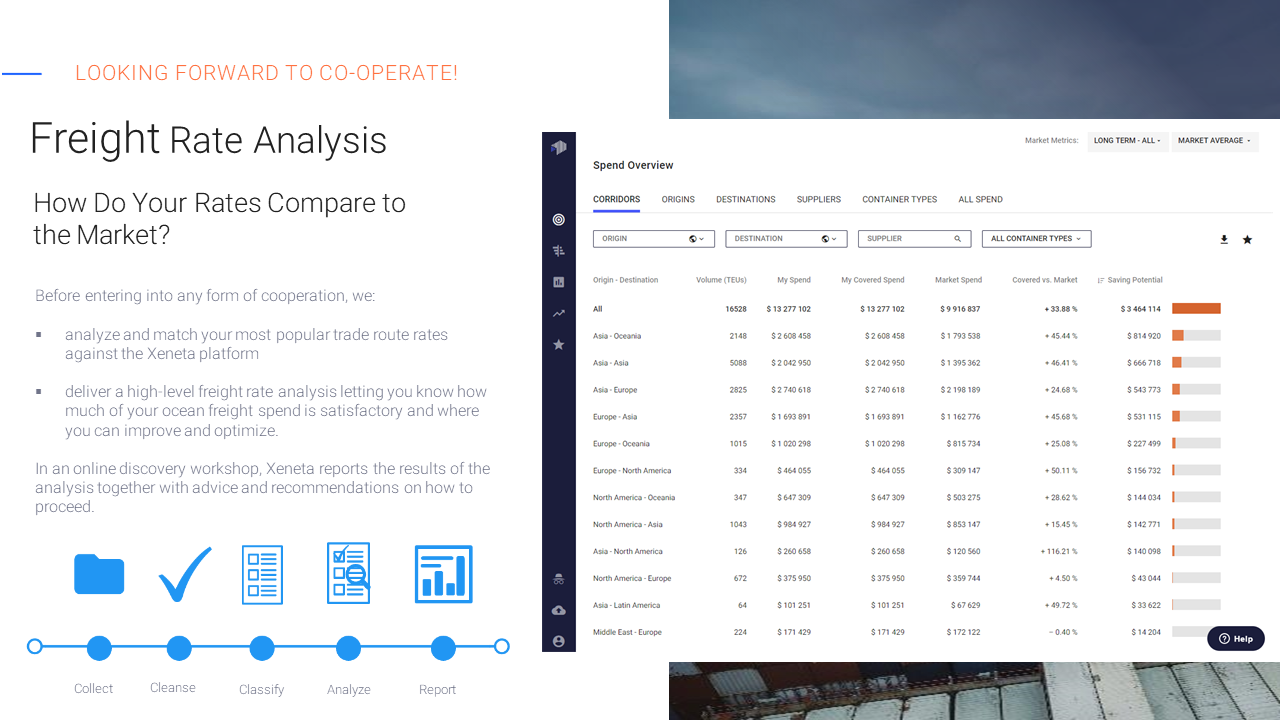
[30:46] We can create a case and go through what Michael did, pertinent to where you're trading on, for the lanes that are important for you, the port‑to‑port combinations.
[30:57] We can have an online discovery workshop, present to you what we found with your rate data, and see how you can best use Xeneta in your everyday, for your sourcing teams and in your procurement work.
[31:12] You can very much just get in contact with us. One of our ocean experts will get back to you. At the same time, I really encourage you to follow us on our blog. We do put a lot of insights of what we find in our data in our blog.
[31:23] If you can sign up to that at Xeneta Blog then you'll get a lot of updates. We of course won't share your information. Everything is kept private. You are free to unsubscribe to the information, which we hope you don't.
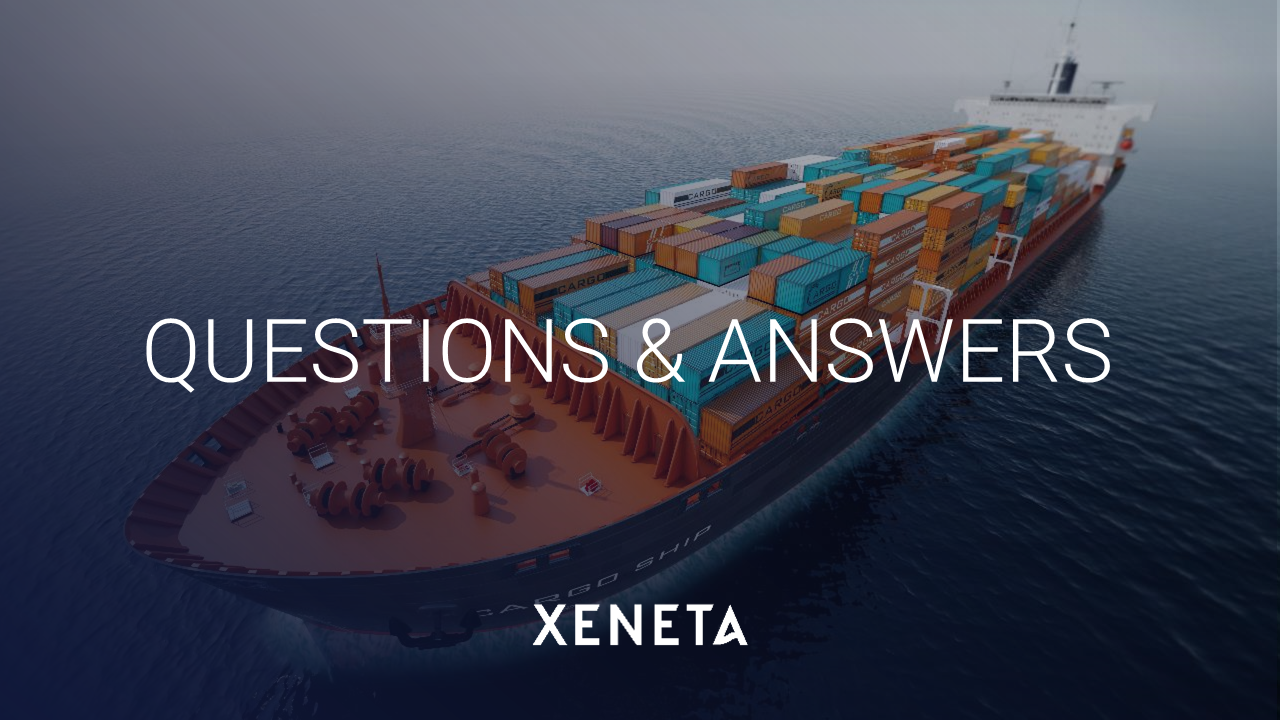
Questions and Answers
Q 1) How does a company ensure they obtain space in the FAK(Freight All Kinds) market when it's as volatile as it was in April?
A 1) On the FAK market, it's pretty much a question of supply and demand and the corresponding volumes, which are handled by the freight forwarders. Let's say that at the moment, when you usually arrange contracts, you have certain volumes, you have to just follow‑up, observe if there's no conflicts on top.
That's the reason why the market is volatile. Due to the fact, that depending on the volatility or of the demand and the volumes behind, the volumes are changing. That's why you have to closely follow‑up on a daily basis.
That's the reason why our freight forwarders are looking into our market development on a daily basis because it gives them a significant importance then to see, "OK, do I get a volume decrease or capacities decrease because the short‑term market is going crazy?" Then they know that you have to be really alert on that one.
Q 2) How do these rates compare to SCFI (Shanghai Containerized Freight Index) or CCFI (China Containerized Freight Index)?
A 2) When we look at the short‑term market and of course, only the average because the SCFI and the CCFI only display averages, then they get very close to each other. I haven't gotten a thing now to lay the two over them, but they are really close to each other.
We perceive the SCFI a little bit more volatile even as it's more triggered by Chinese freight forwarders and also a stronger portion on Chinese markets. It looks to be a little bit calmer when it comes to European and US based shippers in that context. That's the point. It's only the average.
What we put on top is the minimum and the maximum. The full spread of the market which is, of course, varying significantly as well. On top, of course, the whole long‑term market, the real contract at long‑term rates, six months, one year, three months with long‑term shippers with large volumes and so on. That's the comparison.
Q 3) Which period do you cover for the historical data?
A 3) The last three years since we have started. Let's say the level of quality we have today, we have now the data around for two years. As they are coming, another two million rate levels every month. It will definitely stay on that level for the future. Two to three years I would say.
Q 4) Is it possible to evaluate prices from port‑to‑port or just by region?
A 4) It's done through port‑to‑port. Sometimes if port‑to‑port coverage is not that high, then we go up on a country cluster, but that's something which we can clearly identify for each and every shipper, even before they sign.
Q 5) Do the rates represent only the core rate or they also include any kind of surcharges like THC, fuel?
A 5) No, they are all‑in rates. All‑in rates refer to the ocean freight and then the THC can be adjusted following up on the incurred terms of the customer, depending on if you have a CY‑CY rate or a "getting it out" rate. They are incorporating all surcharges relevant in ocean freight, excluding then inland and customs clearance and these things.
Q 6) Who supports Xeneta with rate, spot, and long-term contracted rates?
A 6) Spot market is pretty much freight forwarders. Two out of three top freight forwarders of the world work with us. It's 7 out of the top 20, or 8 out of the top 20, so we have a very profound customer base there. Then on the other side, when it comes to long‑term rates, it's 80 to 90 percent.
It's long‑term rates from shippers directly. Mostly BCOs, sometimes working with freight forwarders. Then we have a couple of long‑term rates from the freight forwarders where they have their accounts themselves. It's like 90 percent coming from the BCO on large shipper side.
Large shipper means widespread, so it starts from around 5,000 TEUs and goes up to half a million. That's an equal spread in between. We have shippers from all classes between 5, 25, 50, 100, 200, and 500 thousand.
###
If you missed any our webinars – or simply want to refresh your memory – you can access all of them on demand here.
See you next time!



